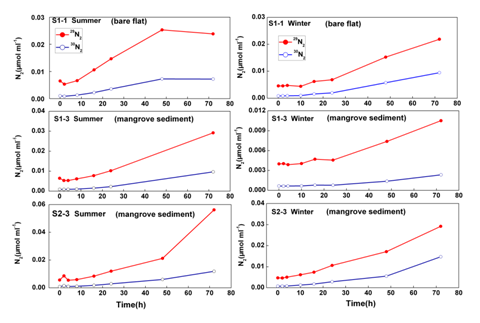作 者:Cao, WZ; Guan, QS; Li, Y; Wang, M; Liu, BL
影响因子:2.522
刊物名称:JOURNAL OF SOILS AND SEDIMENTS
出版年份:2017
卷: 17(6) 页码: 1767-1776
PurposeMangrove forests, common in subtropical coastal regions, are known for their nitrogen (N) buffering capacity. The aims of this study were to examine temporal and spatial variations in denitrification and anaerobic ammonium oxidation (anammox) in mangrove sediments and to assess their contributions to nitrogen gas (N2) release.
Materials and methodsCores of undisturbed mangrove sediments were collected during low tide. The potential anammox and denitrification rates were estimated by quantifying three forms of N2 produced in a strictly anaerobic incubation of sediment with labeled K15NO3 as the reactive substrate. Water samples from above the sediments were collected and analyzed for ammonium, nitrite, and nitrate concentrations. Results and discussion Denitrification and anammox were more active in summer. The contributions of anammox to total N2 in mangrove sediments were 42–70% (summer), 5–57% (autumn), and 26–43% (winter), respectively. There was no significant difference (P > 0.05) between seasons. Denitrification was the major mechanism of N loss overall; however, anammox was higher in the mangrove sediments in summer. Between 3.5 and 41.2% of dissolved inorganic nitrogen in the overlying water was converted to N2, which accounted for between 9 and 22% of the total N2 produced.
ConclusionsDenitrification and anammox operate simultaneously and make a significant contribution to the production and removal of N2 from mangrove systems. Denitrification was the major mechanism of N loss overall; however, anammox was not negligible in summer.

Fig. 11.Production of 15N2 with time during the incubations at the six sampling sites.

